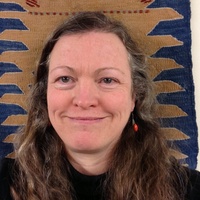
Sinem Türkteki
www.kulluoba.org
less
Related Authors
Nerissa Russell
Cornell University
Colleen Morgan
University of York
David Stuart
The University of Texas at Austin
Don Ross
University College Cork
Alejandra B Osorio
Wellesley College
Philipp Wolfgang Stockhammer
Ludwig-Maximilians-Universität München
Carlos Fabião
Universidade de Lisboa
Mathias Mehofer
University of Vienna
Miljana Radivojević
University College London
Armando Marques-Guedes
UNL - New University of Lisbon
InterestsView All (27)










Uploads
Books by Sinem Türkteki
Günümüzden 12000 yıl kadar önce Dünya’nın Holosen “Yeni Isı” Dönemi’ne girmesi ile insanların sosyo-ekonomik yaşamlarında çok belirgin değişimlerin oluştuğu yapılan arkeolojik araştırmalar sonucunda ortaya çıkmıştır. Mağara ve sığınakları terk ederek uygun sulak açık alanlarda yerleşim yerleri kurmaları ve toplayıcılık ile avcılıktan tarım ve hayvan yetiştiriciliğine geçmeleri, insanların daha çok araç-gereç kullanmalarına neden olmuştur. Yerleşik düzendeki yaşamlarında yiyeceklerini depolamada ve pişirmede, doğadan kolaylıkla elde edilebilen kilin plastik özelliği nedeni ile çok kullanışlı olduğunu keşfeden insanın, su ihtiyacını karşılamada da kili fırınlayarak elde ettikleri kapları kullanmış olduğunu arkeolojik araştırmalarda ele geçen örnekler göstermektedir..........
Since mankind appeared on the face of the earth, his most immediate need has been water. In the Pleistocene Era, that is to say throughout the Ice Ages, human beings could quench their thirst without any help, using their hands or indeed only their mouths; they left no evidence of vessels and containers. Of course they may have used perishables found in nature: wood or the bark of trees may have served as water glasses.
It was first at the beginning of the Holocene post-glacial period some 12,000 years ago that mankind first left traces in the archaeological record that signified a clear socioeconomic development. Leaving their caves and rock shelters behind, the population sought out well-watered sites to settle in, relinquishing hunting and gathering for a new life of husbandry and agriculture—and enlarging their toolkits accordingly. Facing the need to store their food as well as cook it, these community dwellers discovered the plastic qualities of the clay so abundant in nature and learned to fire it, creating durable vessels among them those for water and other drink that have survived for the trowel of the archaeologists.........
Papers by Sinem Türkteki
and their parallels in Anatolia.
can be identified as having taken place
across western and central Anatolia
in the late 3rd millennium BC. These
changes are partially related to the
expansion of long-distance exchange
networks connecting Northern Syria
with the Balkans. This phase of increased
interaction is witnessed, among other
classes of evidence, by the spread of
new manufacturing techniques for metal
products and pottery, as well as by the
appearance of luxury items connected
with elite consumption. In this context, a
new form of ritual seems to be connected
with these broader changes, one that
comprises the intentional burial of
artefacts in pits or bothroi.
The aim of this paper is to investigate
the possible significance, origins and
development of this ritual by employing
Küllüoba, an important excavated
settlement in inland western Anatolia, as
the basis for an analysis. The site’s long
stratigraphy crucially covers a phase from
which large amounts of votive pits have
been identified, mostly in the citadel. These
pits generally contain dining/drinking
vessels, animal bones, and intact objects
like figurines, as well as most of the exotic
artefacts found at the site. The content of
Küllüoba’s pits has clear parallels with many
other contemporary sites in the region
and is, therefore, possibly associated with
the long-distance exchange network.
In addition, Late Bronze Age texts
describing witchcraft rituals, as well as
limited archaeological evidence, help to
link these practices with the Hittite world.
Günümüzden 12000 yıl kadar önce Dünya’nın Holosen “Yeni Isı” Dönemi’ne girmesi ile insanların sosyo-ekonomik yaşamlarında çok belirgin değişimlerin oluştuğu yapılan arkeolojik araştırmalar sonucunda ortaya çıkmıştır. Mağara ve sığınakları terk ederek uygun sulak açık alanlarda yerleşim yerleri kurmaları ve toplayıcılık ile avcılıktan tarım ve hayvan yetiştiriciliğine geçmeleri, insanların daha çok araç-gereç kullanmalarına neden olmuştur. Yerleşik düzendeki yaşamlarında yiyeceklerini depolamada ve pişirmede, doğadan kolaylıkla elde edilebilen kilin plastik özelliği nedeni ile çok kullanışlı olduğunu keşfeden insanın, su ihtiyacını karşılamada da kili fırınlayarak elde ettikleri kapları kullanmış olduğunu arkeolojik araştırmalarda ele geçen örnekler göstermektedir..........
Since mankind appeared on the face of the earth, his most immediate need has been water. In the Pleistocene Era, that is to say throughout the Ice Ages, human beings could quench their thirst without any help, using their hands or indeed only their mouths; they left no evidence of vessels and containers. Of course they may have used perishables found in nature: wood or the bark of trees may have served as water glasses.
It was first at the beginning of the Holocene post-glacial period some 12,000 years ago that mankind first left traces in the archaeological record that signified a clear socioeconomic development. Leaving their caves and rock shelters behind, the population sought out well-watered sites to settle in, relinquishing hunting and gathering for a new life of husbandry and agriculture—and enlarging their toolkits accordingly. Facing the need to store their food as well as cook it, these community dwellers discovered the plastic qualities of the clay so abundant in nature and learned to fire it, creating durable vessels among them those for water and other drink that have survived for the trowel of the archaeologists.........
and their parallels in Anatolia.
can be identified as having taken place
across western and central Anatolia
in the late 3rd millennium BC. These
changes are partially related to the
expansion of long-distance exchange
networks connecting Northern Syria
with the Balkans. This phase of increased
interaction is witnessed, among other
classes of evidence, by the spread of
new manufacturing techniques for metal
products and pottery, as well as by the
appearance of luxury items connected
with elite consumption. In this context, a
new form of ritual seems to be connected
with these broader changes, one that
comprises the intentional burial of
artefacts in pits or bothroi.
The aim of this paper is to investigate
the possible significance, origins and
development of this ritual by employing
Küllüoba, an important excavated
settlement in inland western Anatolia, as
the basis for an analysis. The site’s long
stratigraphy crucially covers a phase from
which large amounts of votive pits have
been identified, mostly in the citadel. These
pits generally contain dining/drinking
vessels, animal bones, and intact objects
like figurines, as well as most of the exotic
artefacts found at the site. The content of
Küllüoba’s pits has clear parallels with many
other contemporary sites in the region
and is, therefore, possibly associated with
the long-distance exchange network.
In addition, Late Bronze Age texts
describing witchcraft rituals, as well as
limited archaeological evidence, help to
link these practices with the Hittite world.